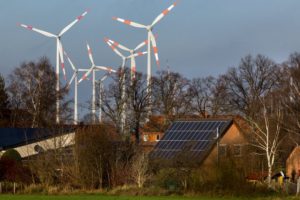 Summary Findings
Summary Findings
These Summary Findings represent a high-level synthesis of the material in the underlying report. The findings consolidate Key Messages and supporting evidence from 16 national-level topic chapters, 10 regional chapters, and 2 chapters that focus on societal response strategies (mitigation and adaptation). Unless otherwise noted, qualitative statements regarding future conditions in these Summary Findings are broadly applicable across the range of different levels of future climate change and associated impacts considered in this report.
Climate change creates new risks and exacerbates existing vulnerabilities in communities across the United States, presenting growing challenges to human health and safety, quality of life, and the rate of economic growth.
The impacts of Read the Full Article

Trump. Governor Brown, and Govenor-elect Nusum. Note Brown’s expression.
The Trump administration attempted to downplay the stark findings of its own climate change assessment, as Democrats sought to pressure the White House to avert looming economic and public health disaster.
The US National Climate change assessment, the work of 300 scientists and 13 federal agencies, was released on Friday afternoon. It found that wildfires, storms and heatwaves are already taking a major toll on Americans’ wellbeing, with climate change set to “disrupt many areas of life” in the future.
The voluminous report, which warns of hundreds of billions of dollars lost, crop failures, expanding wildfires, altered coastlines and multiplying health problems, represents the most comprehensive and sobering analysis yet of the dangers posed to the US by rising temperatures.
Climate change could slash up to a tenth of US GDP by the end of the century, the report found, with $1tn in coastal real estate threatened by rising sea levels and storms. Heatwaves are set to cause thousands of […]

Drs. Roger Rosenberg, left, and Doris Lambracht-Washington have developed a DNA vaccine that can reduce in mice both toxic proteins associated with Alzheimer’s disease. The vaccine has been tested in three mammals with no adverse immune response.
Credit: UT Southwestern
Active full-length DNA Aβ42immunization in 3xTg-AD mice reduces not only amyloid deposition but also tau pathology
- Roger N. Rosenberg,
- Min Fu and
- Doris Lambracht-WashingtonEmail authorView ORCID ID profile
https://doi.org/10.1186/s13195-018-0441-4
© The Author(s). 2018
- Received: 15 March 2018
- Accepted: 12 October 2018
- Published: 20 November 2018
Alzheimer’s disease (AD) is the most well-known and most common type of age-related dementia. Amyloid deposition and hyperphosphorylation of tau protein are both pathological hallmarks of AD. Using a triple-transgenic mouse model (3xTg-AD) that develops plaques and tangles in the brain similar to human AD, we provide evidence that active full-length DNA amyloid-β peptide […]

Credit: Vlad Tchompalov/Unsplash
From anti-war marches in the 1960s to the Tea Party rallies of 2010 and the progressive protests in 2018, marching in the streets are a fixture of modern American life. But do protests actually accomplish anything in terms of election results or the balance of party power?
Coauthored by Sarah A. Soule at Stanford Graduate School of Business and Daniel Q. Gillion at the University of Pennsylvania, the study finds that spikes in both liberal and conservative protest activity can increase or decrease a candidate’s vote by enough to change the final outcome.
“Many people are skeptical that protests matter to electoral outcomes, but our paper finds that they have a profound effect on voter behavior,” says Soule. “Liberal protests lead Democrats to vote on the issues that resonate for them, and conservative protests lead Republicans to do the same. It happens on both sides of the […]

Power from wind and solar waxes and wanes with the breeze and sunshine, not in response to when it is most needed.
Credit Gordon Welters/ The New York Times
Inflation dictates that the cost of living will continue to rise — except, it seems, when it comes to renewable energy. The cost of building a new utility-scale solar or wind farm has now dropped below the cost of operating an existing coal plant, according to an analysis by the investment bank Lazard. Accounting for government tax credits and other energy incentives would bring the cost even lower.
“There are some scenarios, in some parts of the U.S., where it is cheaper to build and operate wind and solar than keep a coal plant running,” said a Lazard banker who was involved in the report. “You have seen coal plants shutting down because of this.”
Every year, the investment bank analyzes the cost of different types of energy using a metric called the levelized cost of energy, or LCOE. This analysis factors in the cost of components and […]










